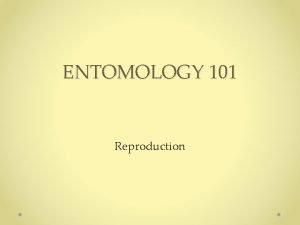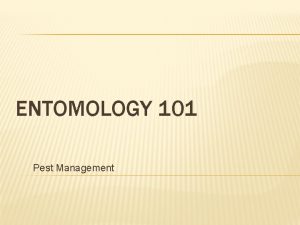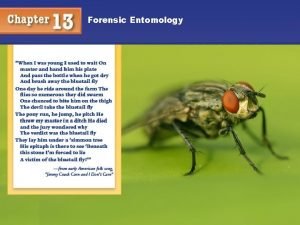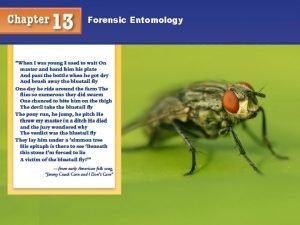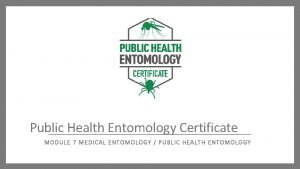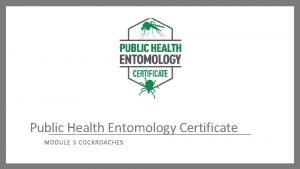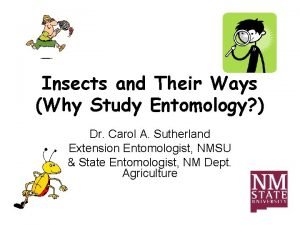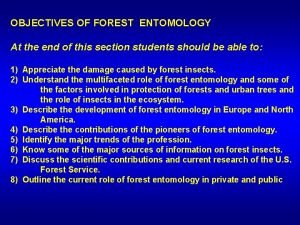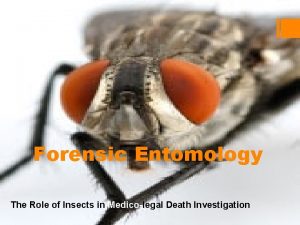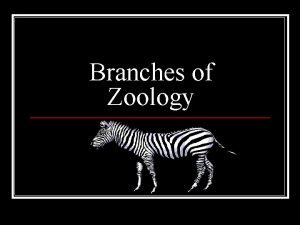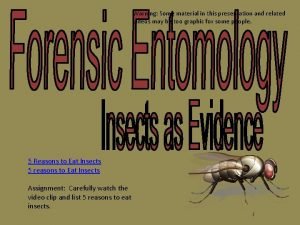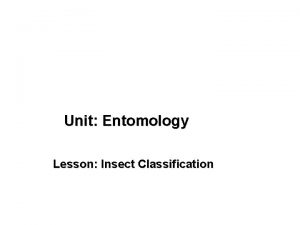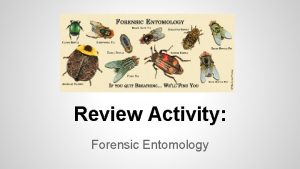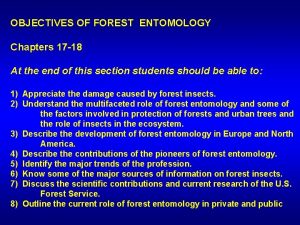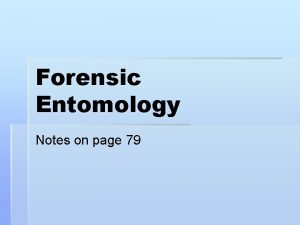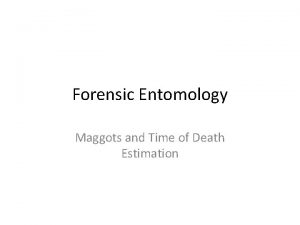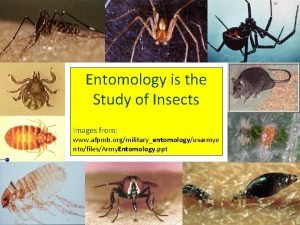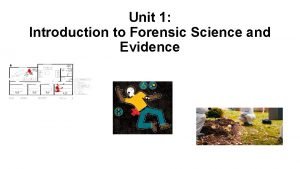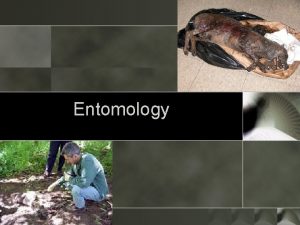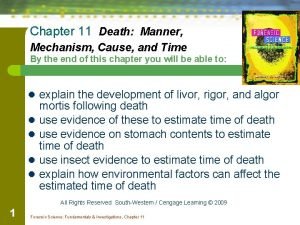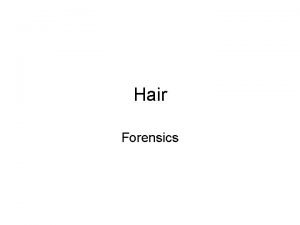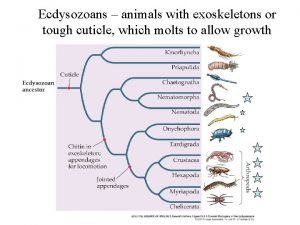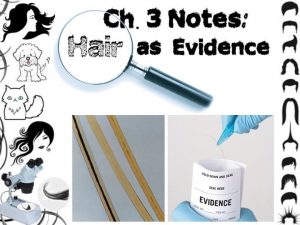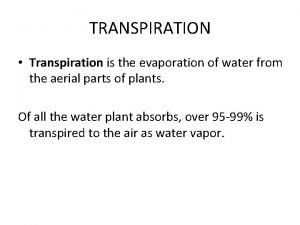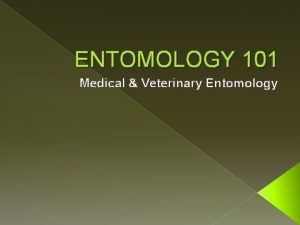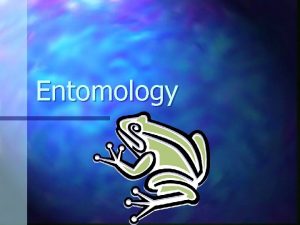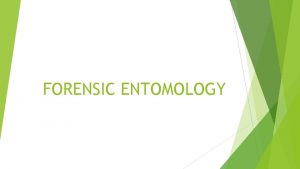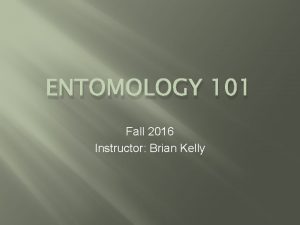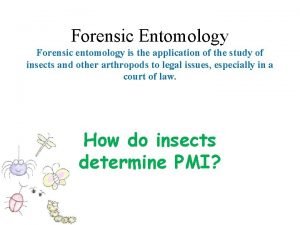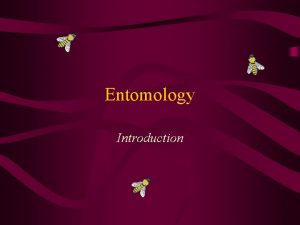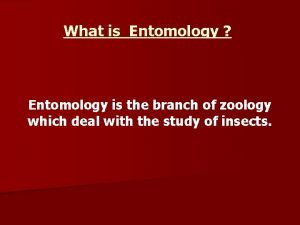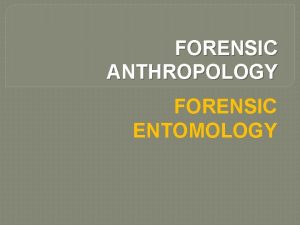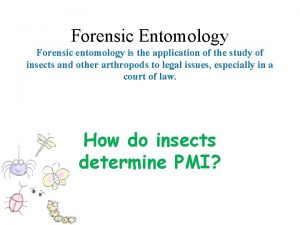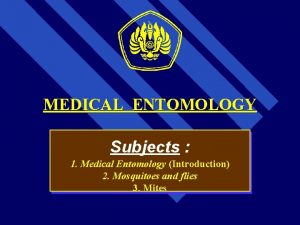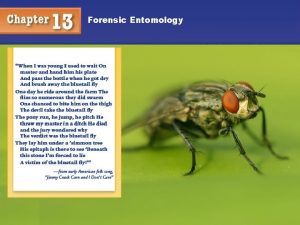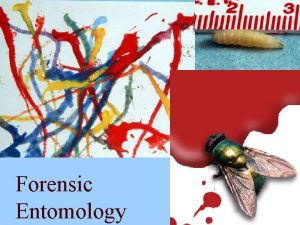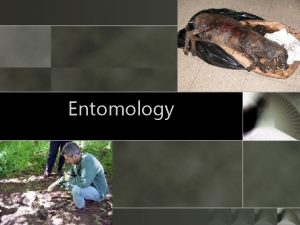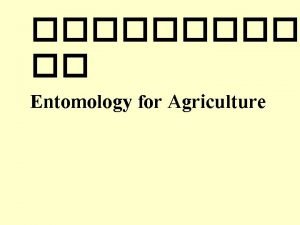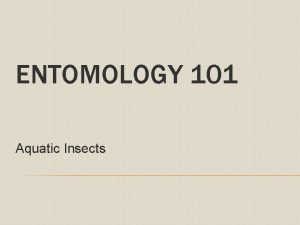ENTOMOLOGY 101 External Anatomy External Anatomy Topics Cuticle






























- Slides: 30

ENTOMOLOGY 101 External Anatomy

External Anatomy • Topics • Cuticle • Segmentation • Head • Thorax • Abdomen

External Anatomy • Types of Metamorphosis - Ametabolous • • • aka “no metamorphosis” Only difference between the immature and adult is the maturation of sex organs Example: Silverfish

External Anatomy • Types of Metamorphosis - Paurometabolous • • • aka “gradual metamorphosis” Nymphs resemble the adults except for body proportions Example: Grasshoppers, Milkweed bugs

External Anatomy • Types of Metamorphosis - Hemimetabolous • • aka “incomplete metamorphosis” Naiad very different from adult in appearance and behavior All are aquatic Example: Dragonflies, Mayflies

External Anatomy • Types of Metamorphosis - Holometabolous • • • aka “complete metamorphosis” Classic or ‘standard’ insect development, found in many orders Example: Butterflies, Beetles, Flies, Bees

The Cuticle • • Much like skin and bones, all in one Key contributor to the success of insects • • • Protects against water loss / dessication Acts as a barrier to keep water out Repels pathogens and other disease-causing agents Surface for muscle attachment Sensory interface with the environment

The Cuticle • Molting, or “Ecdysis”

The Cuticle • Forms: • Structure & Function of the various layers of the cuticle:

The Cuticle • Chitin • • • Key supporting element in exoskeletons and extracellular structures Gives the cuticle rigidity and strength One of the most important biopolymers in nature Mainly produced by fungi, arthropods, and nematodes Arthrodial membrane • Up to 20 -fold expansion

The Cuticle • Cuticular extensions – Spines

The Cuticle • Cuticular extensions – Setae • Help the insect sense: • • • Sound Touch Humidity Light Wind direction Cockroaches

The Cuticle • Cuticular extensions – Setae

The Cuticle • Colors - Produced by different means (or a combination) • • Physical: scattering, interference, diffraction Chemical: by pigments in three ways • • Insect’s metabolism Sequestration from plant source Microbial endosymbionts “Blue Moon Cicada” • Insectoverdin: green pigment produced by mixture of tetrapyrrole (blue) and carotenoid (yellow) compounds. If carotenoids are missing, blue cicadas occur

Segmentation & Tagmosis • 3 distinct regions: • Head • • • Thorax • • • Composed of 6 segments Fused into rigid capsule Composed of 3 segments Contains attachment sites for leg / wing muscles Abdomen • • Composed of 11 segments Typically not rigid, somewhat flexible or soft

Segmentation & Tagmosis • • Bilateral symmetry Orientation

The Head

The Head ● Mouthparts ● Important for classification and taxonomy ● 5 basic components of mouthparts 1. 2. 3. 4. 5. Labrum - the ‘upper lip’ Hypopharynx - divides mouth cavity Mandibles - cut/crush food; defense Maxillae - assist in processing food Labium - the ‘lower lip’ � Many different types

The Head Common types of mouthparts • 1. Chewing • Beetles, Hoppers, Caterpillars 2. Piercing/Sucking • True bugs, Mosquitos 3. Siphoning • Butterflies 4. Sponging • Flies 5. Other types • Positioning of mouthparts

The Head • Antennae types

The Thorax • Composed of 3 segments • • Prothorax Mesothorax Metathorax Spiracles

The Thorax • Legs • Segments

The Thorax • Legs • Tarsomeres • Pulvilli

The Thorax • Legs • -orial leg adaptations • Prolegs

The Thorax • Wings • As a general rule, fully developed wings are found only in adult insectsthe only exception being the mayfly Basic wing venation, shared by most orders • Open / closed cells •

The Thorax • Wings • Fore / hind wings • • Forewing modification • • Coupled together in most orders Elytra, tegmina, etc. Hindwing modification • Halteres

The Abdomen • • 11 segments Ovipositor • • • Modified as sting Cerci Identification • Examination needed

Pictures by Slide no modifications were made to any pictures on any of the slides 1. 2. 3. 4. 5. 6. 7. 8. 9. 10. 11. 12. 13. 14. 15. 16. 17. 18. 19. 20. 21. 22. 23. 24. 25. 26. 27. (no picture) https: //www. uky. edu/Ag/Entomology/ythfacts/4 h/unit 2/metavari. htm (permission granted) https: //pixabay. com/fi/hyönteiset-kirva-nivelkärsäisiä-563256/ Molting: 1. Cicada: https: //commons. wikimedia. org/wiki/File: An_adult_periodical_cicada_emerges_from_its_17 -year_nymph_stage, _molts_and_arises_as_a_winged_adult. jpg 2. Butterfly: https: //commons. wikimedia. org/wiki/File: Danaus_plexippus_emerging_from_chrysalis_02. jpg 3. The Far Side Gallery 1 by Gary Larson, 1984, page 128 Cuticle: 1. Beetle: https: //commons. wikimedia. org/wiki/File: Ironclad_female_sjh. JPG 2. Wiley Blackwell: The Insects: An Outline of Entomology, 4 th edition – Figure 2. 1 Wiley Blackwell: The Insects: An Outline of Entomology, 4 th edition – Figure 2. 4 Cuticular extensions: 1. Wiley Blackwell: The Insects: An Outline of Entomology, 4 th edition – Figure 2. 6 2. https: //commons. wikimedia. org/wiki/File: Australian_Walking_Stick. jpg Wiley Blackwell: The Insects: An Outline of Entomology, 4 th edition – Figure 2. 6 https: //en. wikipedia. org/wiki/File: Sarcophagid_fly_Portrait. jpg https: //commons. wikimedia. org/wiki/File: Chrysiridia_Madagascarensis 2%28 Better_Crop%29. JPG https: //commons. wikimedia. org/wiki/File: Steinfliegen. Larve 2. JPG Wiley Blackwell: The Insects: An Outline of Entomology, 4 th edition – Figure 2. 8 Wiley Blackwell: The Insects: An Outline of Entomology, 4 th edition – Figure 2. 9 The Head � The Far Side Gallery 5 by Gary Larson, 1995, page 153 � https: //commons. wikimedia. org/wiki/File: Titanus_giganteus_MHNT_vol_ventre. jpg Wiley Blackwell: The Insects: An Outline of Entomology, 4 th edition – Figure 2. 13 Wiley Blackwell: The Insects: An Outline of Entomology, 4 th edition – Figure 2. 19 https: //commons. wikimedia. org/wiki/File: Actias_selene_5 th_instar_spiracles_sjh. jpg Wiley Blackwell: The Insects: An Outline of Entomology, 4 th edition – Figure 2. 21 Legs 1. Tarsomeres: https: //commons. wikimedia. org/wiki/File: Tillus_elongatus_tarsus. jpg 2. Pulvilli: Wiley Blackwell: The Insects: An Outline of Entomology, 4 th edition – Chapter 2 vignette 3. The Far Side Gallery 4 by Gary Larson, 1993, page 154 Legs 1. Mole cricket: https: //en. wikipedia. org/wiki/File: Gryllotalpa_2009_G 5. jpg 2. Prolegs: https: //commons. wikimedia. org/wiki/File: Chenille_de_Grand_porte_queue_%28 macaon%29_Fausses_pattes. jpg Wiley Blackwell: The Insects: An Outline of Entomology, 4 th edition – Figure 2. 23 Wings 1. Beetle: https: //commons. wikimedia. org/wiki/File: Maybug. jpg 2. Crane fly: https: //commons. wikimedia. org/wiki/File: Crane_fly_halteres. jpg https: //commons. wikimedia. org/wiki/File: Tettigonia_viridissima_AB. jpg

Questions?

Permission
 Ovivoparity
Ovivoparity Entomology 101
Entomology 101 Forensic entomology equipment
Forensic entomology equipment Forensic entomology
Forensic entomology Public health entomology certificate
Public health entomology certificate Do cockroaches live in cocks
Do cockroaches live in cocks Comparison clue example
Comparison clue example Why study entomology
Why study entomology Father of forest entomology
Father of forest entomology Medicolegal forensic entomology
Medicolegal forensic entomology Branches of zoology
Branches of zoology Blowfly girl deer pictures
Blowfly girl deer pictures Siphonaptera
Siphonaptera What does pmi stand for forensic entomology
What does pmi stand for forensic entomology Father of forest entomology
Father of forest entomology Forensic entomology
Forensic entomology Maggots
Maggots Definition of forensic entomology
Definition of forensic entomology Crime solving insects answer key
Crime solving insects answer key Bobby poole ronald cotton
Bobby poole ronald cotton Pro corbis
Pro corbis Anthropology
Anthropology Entomology is the study of
Entomology is the study of Chapter 11 forensic entomology
Chapter 11 forensic entomology Pattern
Pattern Cuticle in animals
Cuticle in animals Hair as evidence
Hair as evidence Stomatal transpiration
Stomatal transpiration Cuticle forensic science definition
Cuticle forensic science definition Cuticle invasion
Cuticle invasion Cuticle leaves
Cuticle leaves
